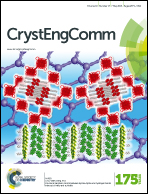Temperature dependence of the photoluminescence from ZnO microrods prepared by a float zone method†
Abstract
A facile float zone method to grow ZnO microrods with a hexagonal crystal structure is described. It was found that the crystal-growth mechanism was different from the well-known vapor–liquid–solid (VLS) growth mechanism. However, the one-dimensional growth morphologies occurring in the vapor phase are similar to those of ZnO grown using conventional VLS processes. The free-exciton, bound-exciton, acceptor-exciton, two-electron satellite emission, and their phonon replicas, obtained from the 15 K photoluminescence (PL) spectra of the ZnO microrods, were recorded. The PL spectra of the ZnO microrods at temperatures between 15 and 150 K show that the bound-exciton peak dissociates into a free-exciton peak and that the free-exciton emission and its phonon replicas dominate at temperatures above 120 K. Following the approach of Viswanath for measuring the intensity ratio of PL peaks, we found that the strongest bound-exciton peak at 3.3615 eV had a thermal activation energy of 15.9 meV, consistent with the value expected for the exciton-defect binding energy. This bound-exciton peak was not observed at temperatures above 120 K.


 Please wait while we load your content...
Please wait while we load your content...